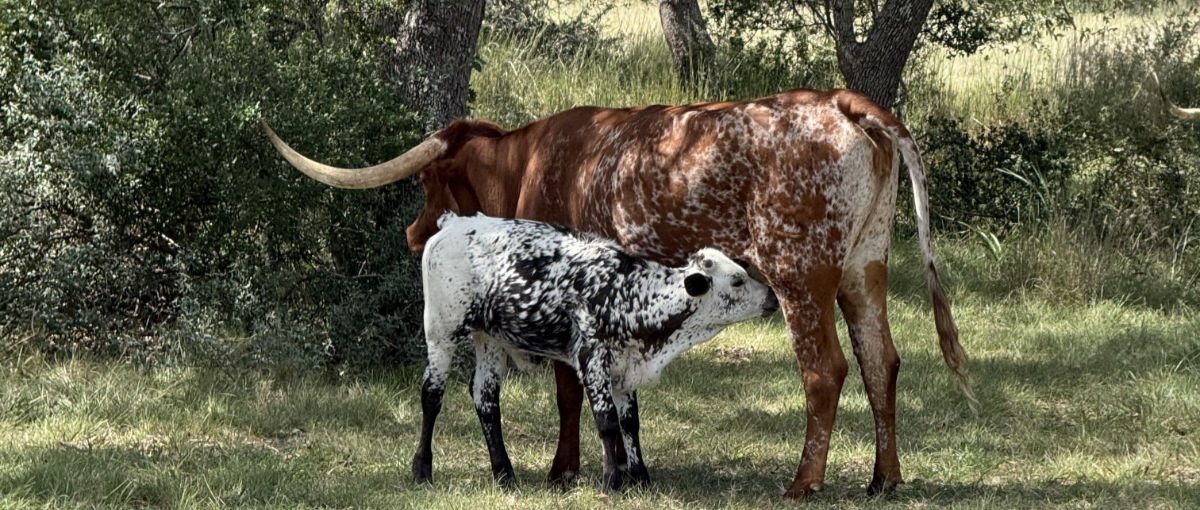Alert: Photos of a snake appear at the end of this post — there will be a chance to bail out before they appear!
It seems like there’s a lot going on in the world right now that has the potential to stir up some strong — and often unhelpful — emotions. Guess what? I don’t intend to write about any of them. I think it’s more fun to focus on some of Nature’s wonders, big and small. I trust you’re on board with that.
This summer’s weather has been a bit weird. Here at Casa Fire Ant, we recorded 16″ of rain in May, June, and early July, and no triple digit temperatures. But the last significant rainfall was during the Fourth of July weekend (I think we all know how that unfolded), and since then, we’ve had less than 1.5″ of rain as well as some sweltering days. Our landscape has gone from beautiful to bleak, seemingly overnight. Bans on outdoor burning have been reinstituted across the Hill Country, and the creek behind our house is down to a mere trickle (but it is still flowing, bless its heart).
Still, Nature has a way of coping, and we’ve been blessed with some observations that serve to puzzle, delight, and reassure. I’d like to share a few of those observations.
UFIs (Unidentified Flying Insects)
Take a look at this short video and try not to be intrigued:
You may be thinking, OK…interesting, I guess, but not really a big deal. I get it, but consider this: this video is actually in slow-motion (taken with an iPhone 16 Pro). Those insects — which I’ve thus far been unable to identify — are moving at least four times as fast as the video shows.
I did manage to grab a frame out of the video, but it’s not very helpful for identification purposes. The wings are moving so fast as to be almost invisible. I’ve put a rough outline around the body and the wings in the photo to help you visualize it.
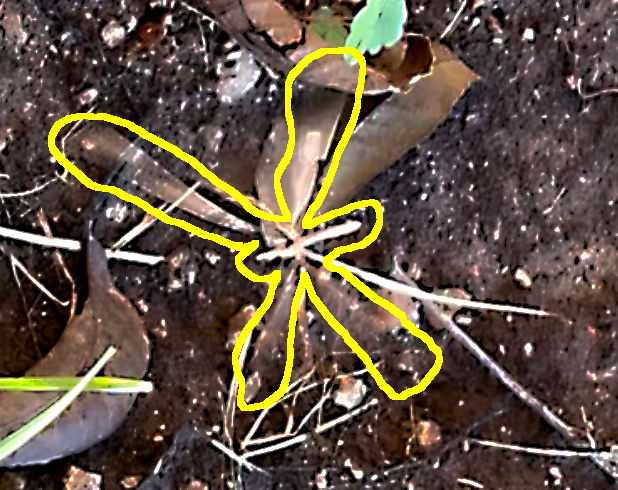
I’ve uploaded the video and the photo to insect identification pages on both Facebook and Reddit. One Redditor thinks it’s a crane fly, which are indeed common around here during mid-summer. I pointed out that the mystery fly appears to have four wings while the crane fly has only two, but he thinks the video might be misleading, in a similar way to an airplane’s propeller appearing to rotate the opposite direction from the way it’s really going, and I agree that’s a possibility.
Update: I’m going with the crane fly identification, until someone can offer a compelling reason not to.
Observing a Wake
Debbie came in the house a week or so ago and said that she feared that something died under our deck because she detected a foul odor in the back yard. (It wouldn’t be the first time.) I didn’t give it much thought because I’d been out there and didn’t notice anything.
A half hour later, I walked out onto our driveway and, yes, something odoriferious was certainly close by. Fortunately, the smell didn’t seem to be coming from our back yard after all, and as I walked around the corner of the house, the source became obvious…at least from a location perspective. There was a group — aka a wake — of at least 20 buzzards gathered on the ground between our yard and the neighbor’s, and they were obviously fixated on some kind of carcass. The group was comprised of both turkey vultures (Cathartes aura) and black vultures (Coragyps atratus).
With a mixture of curiosity and dread, I slowly approached the gathering to determine what had brought them all together. And, of course, I had my phone fired up to video the proceedings.
I was somewhat surprised to discover that the object of their attention was a squirrel carcass; I fully expected/feared that it would be something larger, like a fawn (definitely worst case) or at least a raccoon or fox. The birds were fighting each other over the tidbits they could tear off the small carcass and if you look closely at the video, you’ll see one of them fly away at around the 25 second mark with a morsel in its mouth.
These birds, despite their homely features and penchant for fighting over dead meat, are generally welcome residents in an area like ours, as they clean up carrion regardless of how the victims died, whether roadkill or predator prey or disease or old age. However, the black vultures have a nasty streak in that they have been known to take live prey (turkey vultures do not). Small or newborn animals are at risk, although I don’t know anyone personally who has lost a pet to one.
After satisfying my curiosity, I went back inside and watched from a window as many of the birds returned to the scene of the dining and continued to bluff and fight each other over the meal. One finally emerged victorious and flew away with the entire carcass in its beak — only to drop it in the creek. Clumsy…but the turtles surely appreciated the unexpected bounty from above.
Squirrels That Rock
I’ve written about our population of rock squirrels (Otospermophilus variegatus) on several occasions. We didn’t see much of them last year. I suppose the construction of the new house next door kept them away; they’re notoriously shy and reclusive. But this year is different. They’re still shy, but we spot them — both adults and juveniles — in our back yard or on our deck and patio daily. They also forage for pecans in our yard, although they don’t seem to do as much digging damage as the tree squirrels.
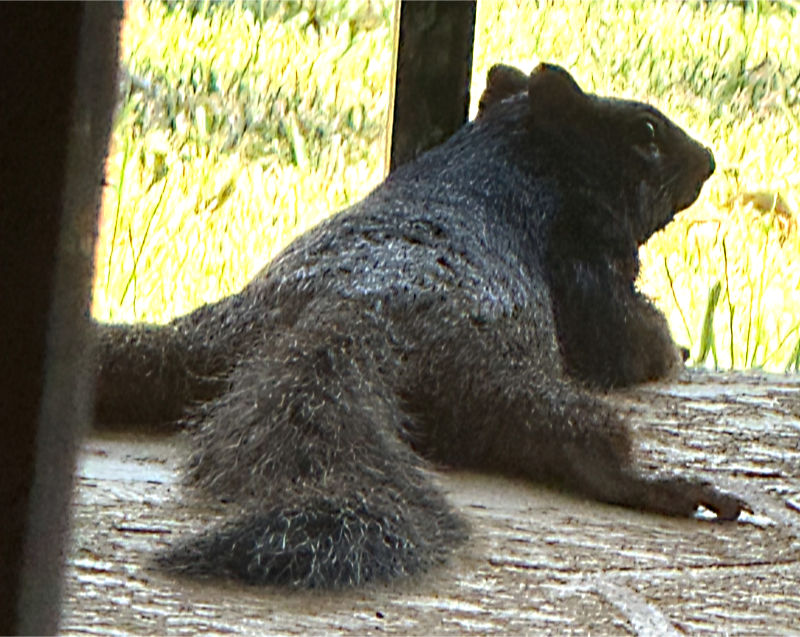
We’ve observed these animals engage in a variety of behaviors over the years, but we saw something different last week as we watched from our breakfast table while one climbed the pecan tree growing through our deck. The Wikipedia article linked above states that they are known to climb trees, but that’s something we had never seen before. Even when startled on the deck, they prefer to scurry across the yard and down to the rocky creek bed. But in this instance, the squirrel meandered up the tree trunk, eventually climbing out onto a small limb some 15 or 20 feet up, and then realized that there was nothing to grab because the gray squirrels had already devastated the pecan crop.
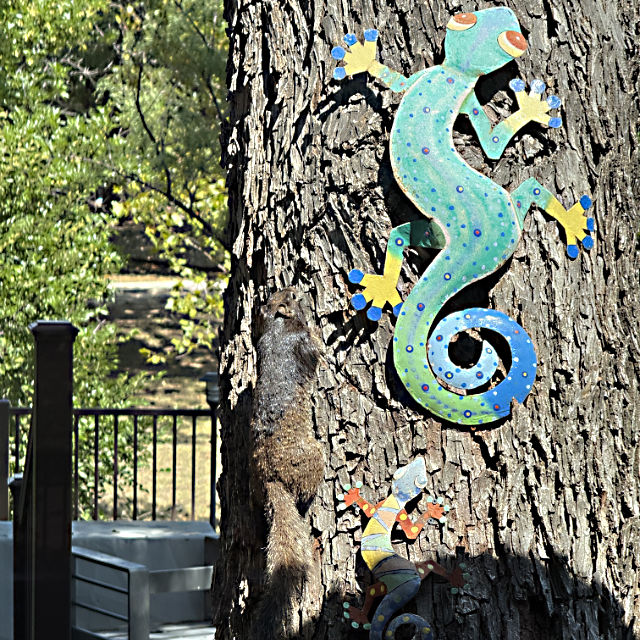


ALERT: SNAKE PHOTOS AHEAD!
Bucket List Sighting: Eastern Hognose Snake
While I wouldn’t go so far as to say that this area is overrun with snakes, the list of different species — venomous and non-venomous — that we’ve encountered is rather lengthy. In fact, I was able to come up with nine (9!) of them [1], seven of which we’ve encountered somewhere in our cul-de-sac, or in the creek behind our house, or — in one memorable case — in our house. This group comprises pretty much all the snake species that are commonly encountered in our immediate vicinity.
But there was one species that has eluded me, the Eastern hognose (Heterodon platirhinos). While they’re not as common as, say, a Western rat snake or a plainbellied water snake, neighbors have spotted them, and Debbie actually watched one quickly disappear into a hole under our house’s foundation. She was able to snap a photo just as it disappeared, but I was too late to the party to be able to add it to my list of sightings.
That changed about a month ago when Debbie called out to me to come see a snake in the back yard (she often spots them before I do). I rushed over and this little dude — I’d say it was about 18″ long — was moving along the base of the deck.
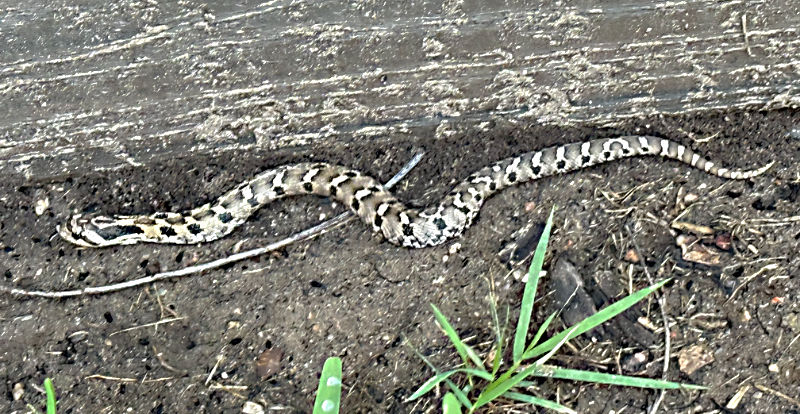
When I first saw the snake, it was partially hidden in the grass and my initial snap i.d. was a juvenile cottonmouth, which we periodically encounter. But when it moved into a more open area, I realized it was a hognose (or “hoggie” if you’re one of the cognoscenti and not someone who would confuse it with a hoagie).
Most hognoses sport a distinctive pattern on their heads and backs, and if you get close enough view them head-on, the snout, from which their name is derived, is a dead giveaway.
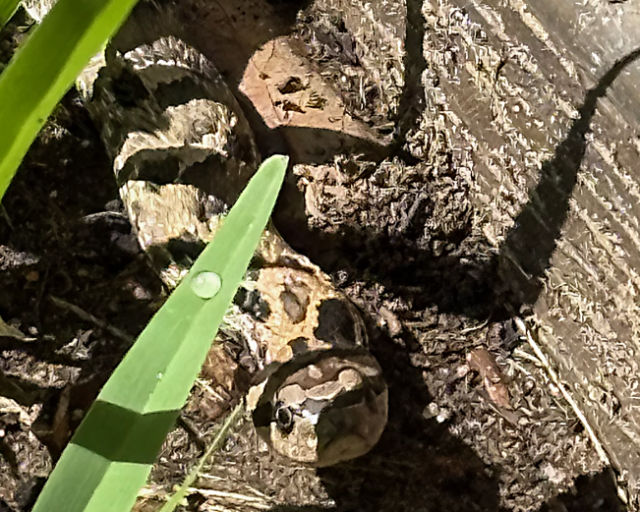
I wouldn’t normally have tried to capture a harmless [2] snake like this, but shortly after we took a few photos, the yard crew showed up for the weekly mowing and edging, and I feared for the little guy’s life. Debbie ran into the garage to get our snake grabber while I kept an eye on him, and I was able to pick him up and put him in a bucket just as one of the workers came on the scene. (I’m calling “it” a “him” because I’m not qualified to sex snakes, nor is it something I’ve hankered to add to my curriculum vitae. But if you’re really curious, here’s how you would do it.)
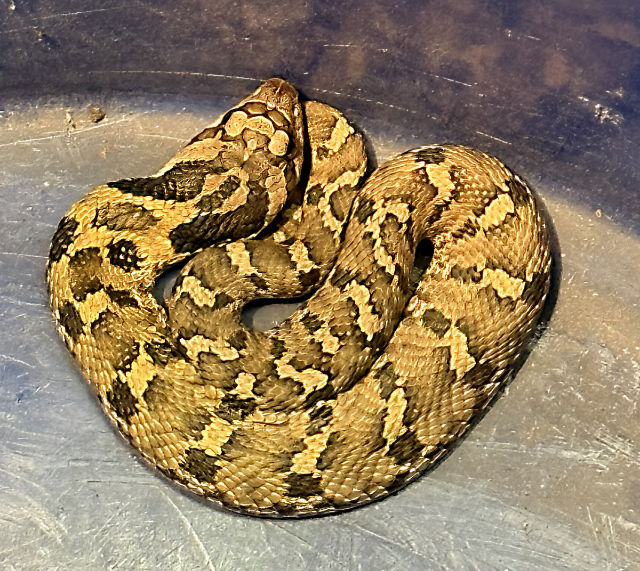
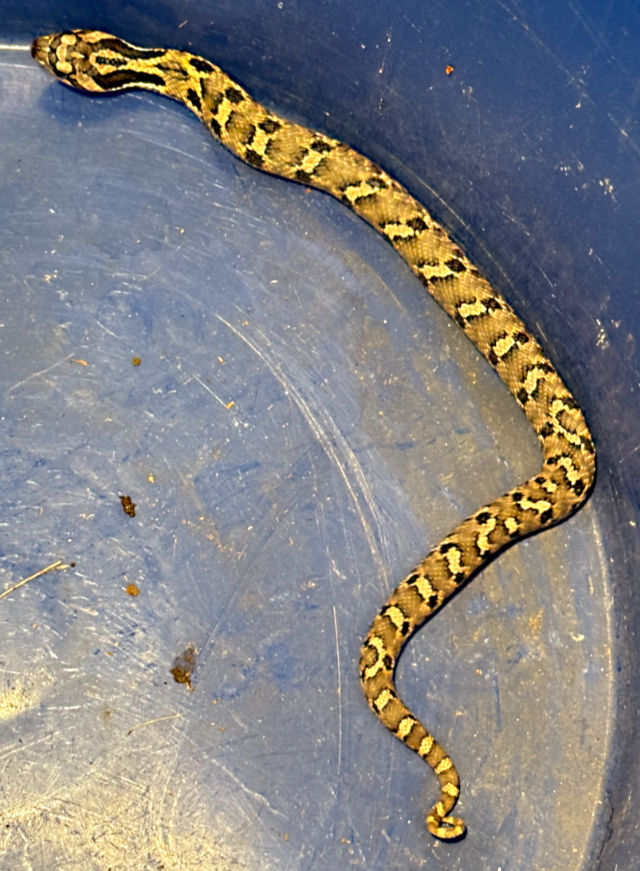
I found it interesting that the snake did not display the defensive posture it’s well-known for, that of rolling onto its back, mouth agape and tongue hanging out, attempting to appear dead (said behavior giving rise to its sobriquet of the opossum of the snake world…no, wait, that’s not right…it’s the snake of the opossum world. Well, that doesn’t sound right, either, which is embarrassing because I just made up both of them.). In fact, it was quite calm, perhaps sensing that we meant it no harm and also that we saved it from potential dismemberment by lawn mower. (There I go — anthropomorphizing once again.)
Anyway, I was quite pleased to add one more sighting to our list, and not only to see it, but also to interact a bit with it. After the lawn crew left, we returned it to its original location where it quickly found a gap and slithered under the deck, living to hunt toads and frogs once again.
By the way, apropos of not much, there are two significant snake species that are still on my wish list, and both are venomous: the Eastern copperhead (Agkistrodon contortrix) and the Texas coral snake (Micrurus tener). The latter has been spotted several times in our neighborhood, but not by me (other than the carcass of one that someone beheaded and left by the side of the road). Copperheads are also indigenous to this region, but are well camouflaged and not common. Wish me luck!
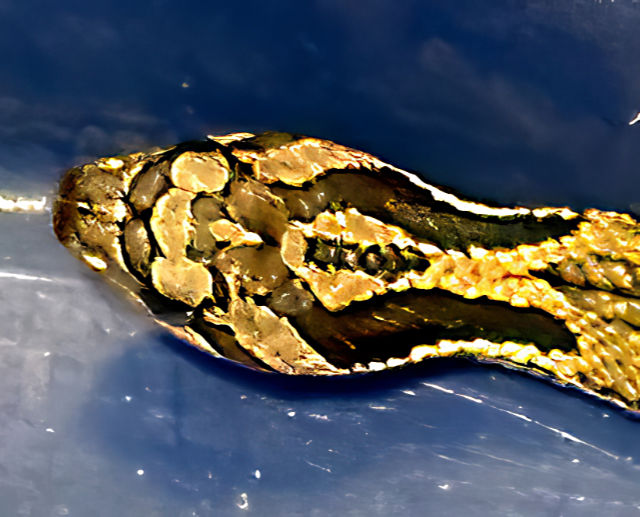
Footnotes (no offense to footless snakes)
[1] I’m sure you’re anxious to see the list of our snake sightings, so here goes, in no particular order:
- Western rat snake (Pantherophis obsoletus)
- Rough green snake (Opheodrys aestivus) – uncommon
- Western ribbonsnake (Thamnophis proximus) – the home invader
- Plain-bellied water snake (Nerodia erythrogaster)
- Diamondback water snake (Nerodia rhombifer)
- Northern cottonmouth (venomous) (Agkistrodon piscivorus)
- Dekay’s brown snake (Storeria dekayi)
- Western coachwhip (M.f. testaceus)
- Western diamondback rattlesnake (venomous) (Crotalus atrox)
[Return]
[2] Hognose snakes are actually mildly venomous, but their venom is termed “prey-specific,” meaning that it has evolved to be used to incapacitate their usual food sources, which are amphibians such as frogs, toads, and salamanders. Thus, it’s harmless to humans except in the rare cases of allergic reaction (i.e. anaphylaxis). That said, there have been a few documented instances where a person has suffered a prolonged bite by a captive snake, and has a serious reaction because of the increased volume of venom administered by the snake. Hognoses are rear-fanged, and use those fangs to deflate and envenomate toads so they can swallow them, and thus they tend not to immediately release their bite. [Return]
Parting Note: I feel seen

Discover more from The Fire Ant Gazette
Subscribe to get the latest posts sent to your email.

